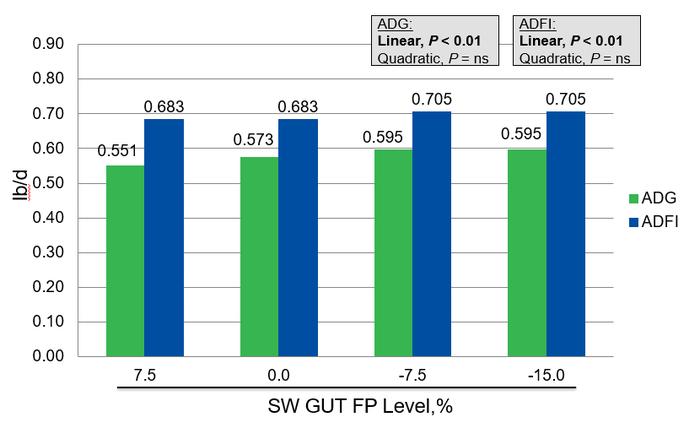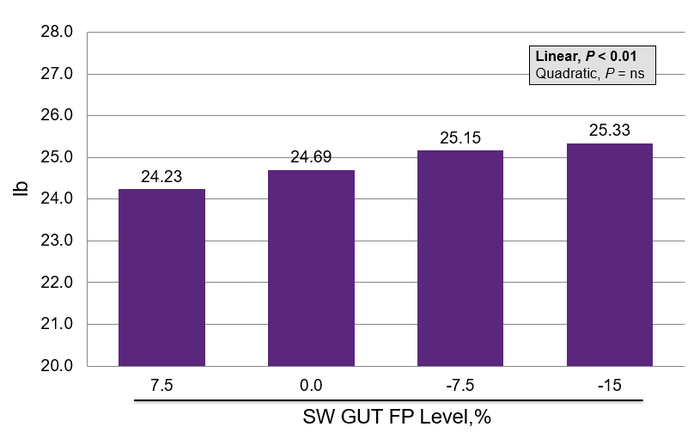Balancing diets using gut fermentable protein levels, or Swine Gut FP, can help support health and immunity in pigs during the weaning transition period.
May 15, 2020

Sponsored Content
It's no secret that pigs with heavier weaning weights transition and perform better later in production. With performance being a major factor in leaving profitability on the table, the economic implications of keeping pigs growing and healthy during the weaning transition makes intestinal immunity a top priority. Restricting the amount of protein entering the hindgut and not being digested early on in the process can aid in preventing stool issues and other immunity challenges.
This relationship between increased fermentable protein (FP), which is the undigested protein that makes it to the hindgut, and gut disturbances, like post-weaning diarrhea, is widely known throughout the pork industry. However, being able to measure and balance diets to this phenomenon has been mostly left to intuition and balancing for crude protein (CP).
What if there was a more accurate and easier way to apply this knowledge to diets on commercial operations? With this in mind, researchers at Provimi, part of Cargill Animal Nutrition and Health, wanted to gain better insights into physiological, nutritional and immunological adaptations occurring in the intestine at weaning to bring practical, on-farm applications of nutritional approaches that support immunity and intestinal function.
The Importance of Intestinal Immunity and the Microbiome Ecosystem
The intestinal microbiome ecosystem is complex and tightly linked to performance and health. The opportunity to understand the role of specific nutrient fractions on the microflora, especially in the weaned pig where intake and nutrient digestibility is often reduced, makes this even more important and impactful. While considerable focus is justifiably placed on the nutrient fraction that is absorbed, understanding undigested nutrients and associated implications on the microflora and intestinal immunity still remains an opportunity.
The Effects of Balancing for Gut Fermentable Protein or Swine Gut FP
The following studies, conducted at Provimi's pork research facility, balanced diets based on gut fermentable protein during the first three weeks post-weaning.
For these studies, each individual ingredient in the diet was given a Swine Gut FP level and the total diet Swine Gut FP was increased by 7.5% or decreased by 7.5 or 15% from the control diet. For US-based diets, a Swine Gut FP level measuring 1.4 or below indicates a low level of gut fermentable protein, with diets measuring 1.2 or lower considered exceptionally low in gut fermentable protein levels.
The Effects of Measuring Gut Fermentable Protein on ADG and ADFI (22.5 days)

The Effects of Measuring Gut Fermentable Protein on Feed to Gain (22.5 days)

The Effects of Measuring Gut Fermentable Protein on Final Body Weight (Day 22.5)

By focusing on this specific nutrient fraction instead of CP, proper evaluation of raw materials in young pig diets can be made to ensure that the primary issues, including undigested protein, are being addressed in the diets instead of secondary causes like CP. There is also the opportunity to easily select ingredients to maintain desired Lysine levels while still reducing CP.
As the Provimi team continues research into the effects of Swine Gut FP, one thing is for sure. The ability to easily quantify and balance diets for Swine Gut FP on commercial operations is one way to take the guess work out of improving profitability and future success of weaned pigs.
For more information on the connection between intestinal immunity and nutrition in pigs, and measuring this in your diets, please check out this Feedstuffs Precision Pork podcast on this topic, or contact our Provimi team today.
About the Author(s)
You May Also Like

.png?width=300&auto=webp&quality=80&disable=upscale)

